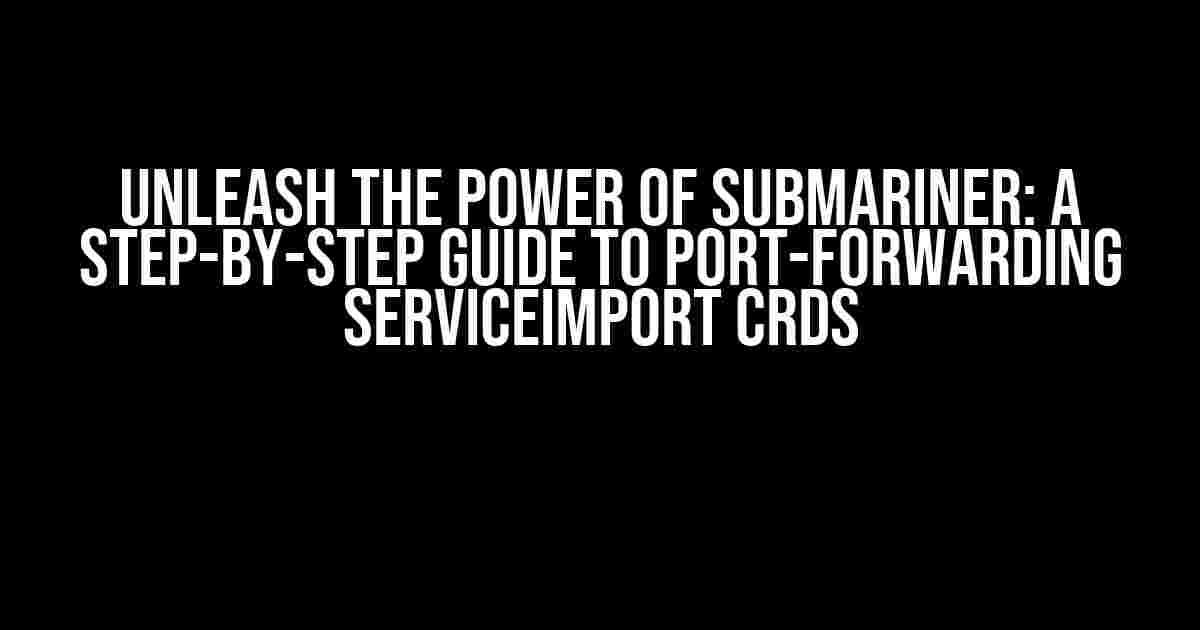Are you tired of struggling with complex cluster communications? Do you want to unlock the full potential of your multicluster environment? Look no further! In this comprehensive guide, we’ll delve into the world of Submariner and explore the art of port-forwarding ServiceImport CRDs. Buckle up, and let’s dive into the depths of this intricate topic!
What are ServiceImport CRDs?
Before we embark on our port-forwarding journey, it’s essential to understand the fundamental concept of ServiceImport CRDs. In a multicluster environment, ServiceImport CRDs (Custom Resource Definitions) are used to expose services from one cluster to another. This allows for seamless communication between clusters, enabling features like service discovery and load balancing.
apiVersion: multicluster.x-k8s.io/v1alpha1 kind: ServiceImport metadata: name: my-service-import spec: clusterName: remote-cluster serviceName: my-service namespace: default
In the above example, we define a ServiceImport CRD that imports the `my-service` from the `remote-cluster` cluster, making it accessible in the `default` namespace of our local cluster.
Why Port-Forwarding ServiceImport CRDs?
Port-forwarding ServiceImport CRDs is crucial when you want to access services from a remote cluster without exposing them directly to the internet. This approach provides an additional layer of security and flexibility, allowing you to control access to your services more granularly. By port-forwarding, you can:
- Securely access services from a remote cluster without exposing them to the public internet
- Split traffic between clusters for better load balancing and scalability
- Implement more complex networking topologies for your multicluster environment
Step-by-Step Guide to Port-Forwarding ServiceImport CRDs
Prerequisites
Before we begin, ensure you have:
- A working Submariner installation (version 0.11.0 or later)
- A multicluster environment with at least two clusters (local and remote)
- A ServiceImport CRD defined for the service you want to port-forward
Step 1: Create a Submariner Gateway
Create a Submariner Gateway on your local cluster to establish a connection with the remote cluster. This will allow you to access services from the remote cluster.
kubectl create gateway submariner-gateway --cluster-name remote-cluster
Step 2: Define a ServiceImport CRD
Define a ServiceImport CRD for the service you want to port-forward. This will allow Submariner to discover the service and its associated endpoints.
apiVersion: multicluster.x-k8s.io/v1alpha1 kind: ServiceImport metadata: name: my-service-import spec: clusterName: remote-cluster serviceName: my-service namespace: default
Step 3: Port-Forward the ServiceImport CRD
Use the `submariner-ctl` command to port-forward the ServiceImport CRD. This will create a tunnel from your local cluster to the remote cluster, allowing you to access the service.
submariner-ctl port-forward --gateway submariner-gateway --service-import my-service-import --local-port 8080
In this example, we’re forwarding traffic from port 8080 on our local cluster to the `my-service` service in the remote cluster, using the `submariner-gateway` gateway.
Step 4: Verify the Port-Forwarding
Verify that the port-forwarding is working by accessing the service using the forwarded port.
curl http://localhost:8080
If everything is set up correctly, you should see the response from the `my-service` service in the remote cluster.
Troubleshooting and Advanced Configurations
Troubleshooting Common Issues
If you encounter issues with port-forwarding, check the following:
- Verify that the Submariner Gateway is running and connected to the remote cluster
- Check the ServiceImport CRD definition and ensure it’s correctly configured
- Verify that the port-forwarding command is correct and the local port is available
Advanced Configurations
Submariner provides advanced configurations for port-forwarding, including:
| Option | Description |
|---|---|
| –ttl | Specify the TTL (time-to-live) for the port-forwarding tunnel |
| –proto | Specify the protocol to use for the port-forwarding tunnel (e.g., TCP, UDP) |
| –bind-address | Specify the bind address for the local port-forwarding endpoint |
These advanced options can be used to fine-tune your port-forwarding setup and adapt it to your specific use case.
Conclusion
Port-forwarding ServiceImport CRDs is a powerful technique for accessing services from remote clusters securely and flexibly. With Submariner, you can unlock the full potential of your multicluster environment and create complex networking topologies. By following this step-by-step guide, you’ll be able to port-forward your ServiceImport CRDs and take your multicluster environment to the next level!
Remember to explore the advanced configurations and troubleshooting tips to optimize your port-forwarding setup. Happy clustering!
Frequently Asked Question
Get ready to dive into the world of submariner services and learn how to port-forward them with ease!
What is ServiceImport CRD and how is it related to submariner services?
ServiceImport CRD (Custom Resource Definition) is a Kubernetes resource that allows you to import services from another cluster. Submariner services use ServiceImport CRD to enable service discovery and access across clusters. Think of it as a bridge that connects your services across different Kubernetes clusters!
How do I port-forward a submariner service using ServiceImport CRD?
To port-forward a submariner service, you’ll need to create a ServiceImport CRD that points to the service you want to access. Then, use the ` submariner-cli` tool to port-forward the service to your local machine. You can do this by running the command `submariner-cli port-forward
What are the benefits of using ServiceImport CRD for submariner services?
Using ServiceImport CRD for submariner services provides a seamless way to access services across clusters. It enables service discovery, load balancing, and failover across clusters, making it ideal for multi-cluster deployments. Plus, it simplifies service access and management, reducing complexity and improving overall application reliability!
Can I use ServiceImport CRD with other service meshes besides submariner?
While ServiceImport CRD is primarily designed for submariner services, it can be used with other service meshes that support multi-cluster service discovery and access. However, you may need to modify the CRD and the port-forwarding process to accommodate the specific requirements of the service mesh you’re using.
Are there any security considerations I should keep in mind when using ServiceImport CRD for submariner services?
Yes, when using ServiceImport CRD for submariner services, you should ensure that the service imports are properly authenticated and authorized. You can use Kubernetes RBAC and network policies to control access to the services and ensure that only authorized entities can access them. Additionally, make sure to monitor and audit access to the services to maintain the security and integrity of your application.


